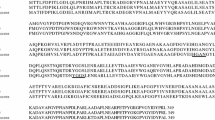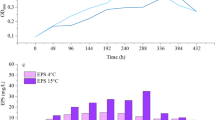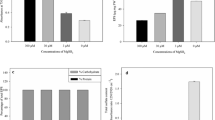Abstract
Scanning electron microscopy revealed pores and wrinkles on the surface of Pseudomonas sp. HK-6 cells grown in Luria Bertani (LB) medium containing 0.5 mM TNT (2,4,6-trinitrotoluene). Exopolymer connections were also observed on the wild-type HK-6 cells but not on the algA mutant cells. In addition, the amount of exopolymer from HK strain increased from 90 to 210 μg/mL under TNT stress, whereas the algA mutant produced approximately 30 μg/mL, and its exopolymer production was little increased by TNT stress. These results indicate that TNT stress induced exopolymer production with alginate as a major component. The algA mutant degraded TNT more slowly than the wild-type HK-6 strain. HK-6 was able to completely degrade 0.5 mM TNT within 8 days, whereas algA mutant only achieved approximately 40% within the same time period. Even after 20 days, no more than 80% of TNT was degraded. According to analyses of proteomes of HK-6 and algA mutant cells grown under TNT stress or no stress, several proteins (KinB, AlgB, Alg8, and AlgL) in alginate biosynthesis were only highly induced by both strains under TNT stress. Interestingly, two stress-shock proteins (SSPs), GroEL and RpoH, were more highly expressed in the algA mutant than the HK-6 strain. The algA mutant was rendered more vulnerable to environmental stress and had reduced ability to metabolize TNT in the absence of alginate synthesis.





Similar content being viewed by others
References
Bagge N, Schuster M, Hentzer M, Ciofu O, Givskov M, Greenberg EP et al (2004) Pseudomonas aeruginosa biofilms exposed to imipenem exhibit changes in global gene expression and ß-lactamase and alginate production. Antimicrob Agents Chemother 48:1175–1187
Chang HW, Kahng HY, Kim SI, Chun JW, Oh KH (2004) Characterization of Pseudomonas sp. HK-6 cells responding to explosive RDX (hexahydro-1, 3, 5-trinitro-1, 3, 5,-triazine). Appl Microbiol Biotechnol 65:323–329
Chang WS, van de Mortel M, Nielsen L, Nino de Guzman G, Li X, Halverson LJ (2007) Alginate production by Pseudomonas putida creates a hydrated microenvironment and contributes to biofilm architecture and stress tolerance under water-limiting conditions. J Bacteriol 189:8290–8299
Chitnis CE, Ohman DE (1993) Genetic analysis of the alginate biosynthetic gene cluster of Pseudomonas aeruginosa shows evidence of an operonic structure. Mol Microbiol 8:583–590
Comfort SD, Shea PJ, Hundal LS, Li Z, Woodbury BL, Martin L et al (1995) TNT transport and fate in contaminated soil. J Environ Qual 24:1174–1182
Cuesta G, Suarez N, Bessio MI, Ferreira F, Massaldi H (2003) Quantitative determination of pneumococcal capsular polysaccharide serotype 14 using a modification of phenol-sulfuric acid method. J Microbiol Methods 52:69–73
Doggett RG, Bentinck B, Harrison GM (1971) Structure and ultrastructure of the labial salivary glands in patients with cystic fibrosis. J Clin Pathol 24:270–282
Fett WF, Osman SF, Fishman ML, Siebles TS (1986) Alginate production by plant-pathogenic Pseudomonads. Appl Environ Microbiol 55:579–583
Ho EM, Chang HW, Kim SI, Kahng HY, Oh KH (2004) Analysis of TNT (2, 4, 6-trinitrotoluene) inducible cellular responses and stress shock proteome in Stenotrophomonas sp. OK-5. Curr Microbiol 49:346–352
Gacesa P (1998) Bacterial alginate biosynthesis-recent progress and future prospects. Microbiology 144:1133–1143
Govan JRW, Fyfe JAM, Jarman TR (1981) Isolation of alginate-producing mutants of Pseudomonas fluorescens, Pseudomonas putida and Pseudomonas mendocina. J Gen Microbiol 125:217–220
Keith LM, Bender CL (1999) AlgT (σ22) controls alginate production and tolerance to environmental stress in Pseudomonas syringae. J Bacteriol 181:7176–7184
Kim YH, Cho K, Yun SH, Kim JY, Kwon KH, Yoo JS et al (2006) Analysis of aromatic catabolic pathways in Pseudomonas putida KT 2440 using a combined proteomic approach: 2-DE/MS and cleavable isotope-coded affinity tag analysis. Proteomics 6:1301–1318
Klausmeier RE, Osmon JL, Walls DR (1973) The effect of trinitrotoluene on microorganisms. Dev Ind Microbiol 15:309–317
Linker A, Jones RS (1966) A new polysaccharide resembling alginic acid isolated from Pseudomonads. J Biol Chem 241:3845–3851
Lizewski SE, Lundberg DS, Schurr MJ (2002) The transcriptional regulator AlgR is essential for Pseudomonas aeruginosa pathogenesis. Infect Immun 70:6083–6093
Ma S, Selvaraj U, Ohman DE, Quarless R, Hassett DJ, Wozniak DJ (1998) Phosphorylation-independent activity of the response regulators AlgB and AlgR in promoting alginate biosynthesis in mucoid Pseudomonas aeruginosa. J Bacteriol 180:956–968
Ma S, Wozniak DJ, Ohman DE (1997) Identification of the histidine kinase KinB in Pseudomonas aeruginosa and its phosphorylation of the alginate regulator AlgB. J Biol Chem 272:17952–17960
Martin DW, Holloway BW, Deretic V (1993) Characterization of a locus determining the mucoid status of Pseudomonas aeruginosa: AlgU shows sequence similarities with a Bacillus sigma factor. J Bacteriol 175:1153–1164
Miller JH (1972) Experiments in molecular genetics. Cold Spring Harbor Laboratory, New York, NY
Nelson KE, Weinel C, Paulsen IT, Dodson RJ, Hilbert H, Martins dos Santos VA (2002) Complete genome sequence and comparative analysis of the metabolically versatile Pseudomonas putida KT2440. Environ Microbiol 4:799–808
Pagès D, Sanchez L, Conrod S, Gidrol X, Fekete A, Schmitt-Kopplin P et al (2007) Exploration of intraclonal adaptation mechanisms of Pseudomonas brassicacearum facing cadmium toxicity. Environ Microbiol 9:2820–2835
Peńaloza-Vázquez A, Saranga SP, Chakrabarty AM, Bender CL (1997) Characterization of the alginate biosynthetic gene cluster in Pseudomonas syringae pv. syringae. J Bacteriol 179:4464–4472
Pertins DN, Pappin DJ, Creasy DM, Cottrell JS (1999) Probability-based protein identification by searching sequence databases using mass spectrometry data. Electrophoresis 20:3551–3567
Priester JH, Olsen SG, Webb SM, Neu MP, Hersman LE, Holden PA (2006) Enhanced exopolymer production and chromium stabilization in Pseudomonas putida unsaturated biofilms. Appl Environ Microbiol 72:1988–1996
Schurr MJ, Deretic V (1997) Microbial pathogenesis in cystic fibrosis: Coordinate regulation of heat-shock response and conversion to mucoidy in Pseudomonas aeruginosa. Mol Microbiol 24:411–420
Smock LA, Stoneburner DL, Clark JR (1976) The toxic effects of trinitrotoluene (TNT) and its primary degradation products on two species of algae and fathered minnow. Water Res 10:537–543
Spratt BG, Hedge PJ, te Heesen S, Edelman A, Broom-Smith JK (1986) Kanamycin-resistant vectors that are analogues of plasmids pUC8, pUC9, pEMBL8 and pEMBL9. Gene 41:337–342
Acknowledgments
This work was supported by grant (R01-2005-000-106080) from the Basic Research Program of the Korea Science and Engineering Foundation. We thank Peter Margolis for critical reading and editorial advice.
Author information
Authors and Affiliations
Corresponding author
Rights and permissions
About this article
Cite this article
Lee, BU., Park, SC., Cho, YS. et al. Exopolymer Biosynthesis and Proteomic Changes of Pseudomonas sp. HK-6 Under Stress of TNT (2,4,6-Trinitrotoluene). Curr Microbiol 57, 477–483 (2008). https://doi.org/10.1007/s00284-008-9272-z
Received:
Accepted:
Published:
Issue Date:
DOI: https://doi.org/10.1007/s00284-008-9272-z




